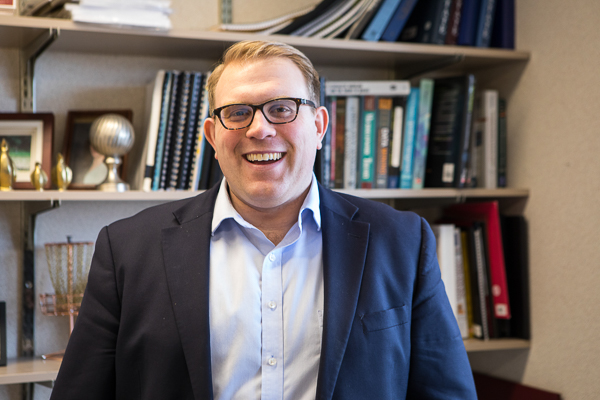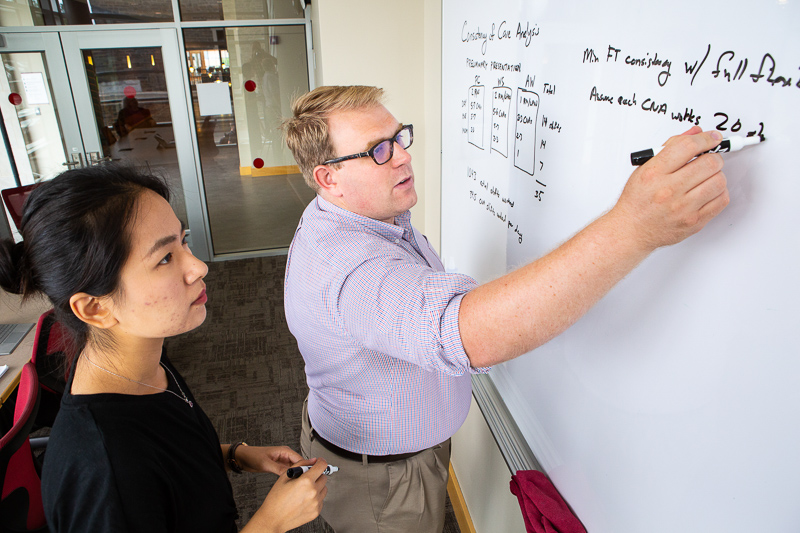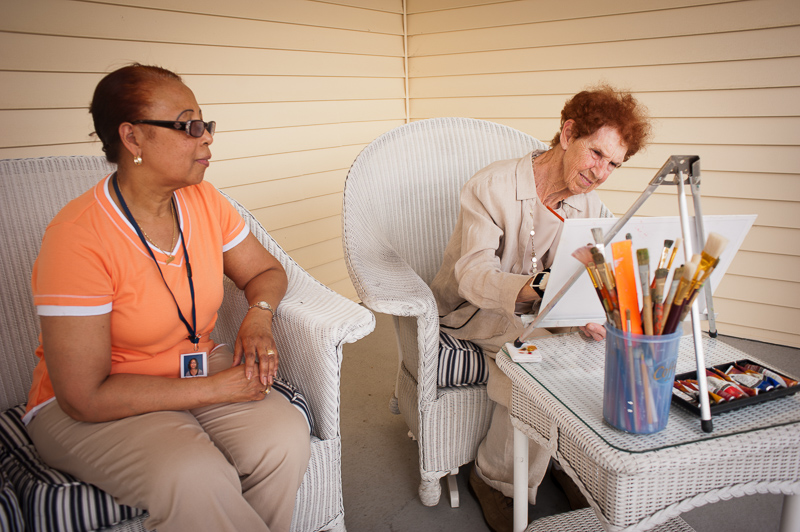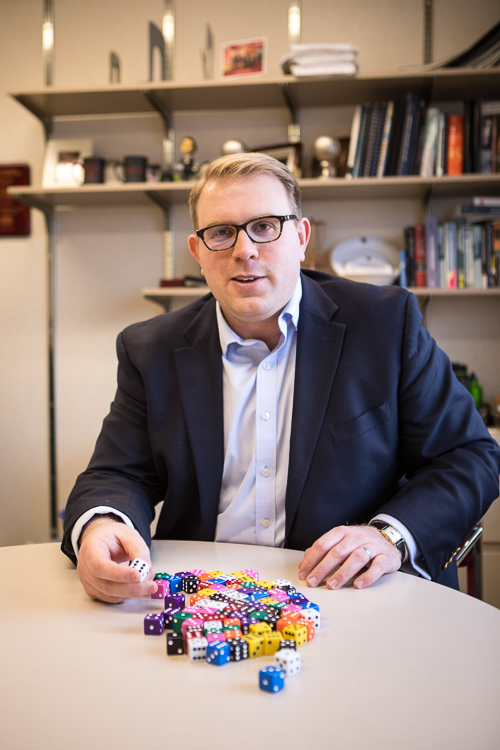Mathematical elegance meets social relevance in the research of Vincent Slaugh

Vince Slaugh got his first opportunity to think about improving nursing-home care when he worked on a pro-bono consulting project as a doctoral student in operations research at Carnegie Mellon’s Tepper School of Business. The subject resonated with him.
“My grandfather, who had multiple sclerosis, spent over a decade in skilled nursing-home care,” said Slaugh, an assistant professor of services operations management who joined the SHA faculty in 2016. “My grandmother, whom I’m still close to, was there in the nursing home almost every day helping my grandfather and doing things with him, so I’m emotionally invested in helping to make these settings more homelike and life-giving.”
The pro-bono project grew into an in-depth study showing that long-term-care facilities can improve consistency of care for residents and save money by developing their own staffing pools to fill in when regular certified nursing assistants (CNAs) are absent.
“When I went for my PhD, I never thought I’d be doing research that my 98-year-old grandmother could understand, let alone research that she has an educated opinion about,” Slaugh said with a smile. “She has a lot of sympathy for the CNAs and how tough the job is to care for people in these settings.”
Toward the business of humanity
One might be more likely to associate operations management with efficiency on the factory floor or with inventory control than with doing good or bringing about social change. But in fact the work that Slaugh and colleagues are doing today is part of what he calls “an interesting trend” in his area of expertise.
“Many of the core business problems, such as inventory optimization, have been studied for a generation, and there isn’t as much uncharted territory,” he observed. “As a result, many scholars in the field are now looking at how to do market design for such nonprofit areas as organ donation and allocation networks, humanitarian supply chains, disaster relief, and distribution of items to parts of the world where they are needed most. It’s really a rich area for research.”
Slaugh’s research interests complement those of other faculty members in the School of Hotel Administration and elsewhere in the Cornell SC Johnson College of Business who are concerned with making healthcare more hospitable and improving the delivery of services more generally. “The Hotel School, with its emphasis on service, is not only a great place to do operations research but also is well positioned to make an impact on the nonprofit world,” he said. “The challenge is to find research topics that have practical relevance and some mathematical elegance and sophistication.”

Slaugh has found at least two. In addition to the question of nursing-home staffing, he has also looked into maximizing adoption opportunities for hard-to-place teenage wards of the state. His studies in both areas have used stochastic modeling, a sophisticated mathematical tool frequently applied by researchers to processes with some element of randomness.
Discussing his nursing-home staffing study, he said, “Consistent staffing is especially important with patients who have Alzheimer’s or are otherwise hampered by memory loss. On-staff CNAs, who know these residents well, are better able to detect changes in their mental and physical states than the patients themselves or staff who have never worked with them before.”
The problem, he noted, is that memory-care facilities tend to rely on temporary staffing agencies that arrange for them to rent nursing aides by the shift. “Nursing-home operators often feel like they must depend on external staffing agencies and have no other options. Having someone analyze the trade-offs, the different outcomes that they hope to achieve, might help them make better decisions.”
Improving consistency of care
Slaugh and his study colleagues, distinguished Tepper faculty members Alan Scheller-Wolf and Sridhar R. Tayur, PhD ’90 (Eng), measured consistency of care by counting the number of different CNAs who entered a resident’s room in one month. The fewer, and the more familiar they were with the residents, the better the care, they determined.
“We developed our analytic model to help people make better decisions when there’s uncertainty and scarce resources,” he explained. “It’s actually a pretty difficult technical problem to solve, but one that the tools of operations management can assist with so that it can be implemented in the real world.”
The team’s paper looked at how one nursing home reacted to last-minute staff absences, referred to as “call-offs,” in terms of consistency of care. “Nationally, the last-minute call-off rate is about 5 percent, so for one out of every 20 shifts each aide works, you’d expect that aide to call off at the last minute,” Slaugh explained. “But there’s a best-case scenario for a nursing home and then there’s what actually happens.

“Depending on the number of caregivers and the number of residents in one ‘household,’” where patient numbers might vary from 12 to 30 patients, “you might think that 10 to 15 nursing aides would be your minimum to cover all the shifts that are needed,” he said. “However, if you look at the real schedules, it can turn out to be 30 or 40 different people—and for a lot of different reasons. Maybe a couple of people work a lot of shifts, and maybe 20 or 30 different people work just one or two shifts.”
One thing is certain, however: “Having strangers or people who aren’t used to the system in a particular nursing home is not good for staff morale or for the care and comfort of residents. Residents’ having to explain their personal care preferences to a new person whom they may never see again does not create a homelike environment.”
Slaugh calls his model a work in progress. “I’m working with other nursing homes and looking into other factors, such as how the schedules are created initially and how workers are assigned to groups of residents to improve the consistency of care. Conventional wisdom is to assign full-time aides and then plug holes in the schedule randomly with part-time aides, but I show that it can be better to focus primarily on consistency with part-time aides and more flexibly assign full-time aides between a primary and a backup group of residents.”
Slaugh’s research was very well received by at least one industry group he addressed, the New Jersey Alliance for Culture Change. “On a visit to Cornell, Professor Slaugh shared with me research that I knew I had to share with people in the field,” said Denise Boudreau-Scott, MHA ’94, the president of Drive, a consulting and coaching company engaged in helping aging-services organizations improve their working cultures. “He graciously came to spend the day with a group of forward-thinking senior-living leaders and shared his insights and tips for improving staffing consistency, which is directly linked to residents’ quality of life. Many of our participants commented that his presentation was the most impactful part of the four-day program they participated in, and that they used what they learned to improve staffing consistency in their nursing homes. I’m incredibly grateful to him for caring about this important field and for enthusiastically sharing his knowledge to make life better for residents.”
The study has since been accepted for publication in Production and Operations Management, the journal of the Society of Production and Operations Management.

Improving adoption odds for teens

In his study of adoption, Slaugh explained, “My colleagues and I worked with a Pennsylvania state agency to help place children for adoption who had trouble finding a family resource at the county level. These were often children who were older and had higher special needs and other demographic characteristics that made them harder to place. We were able to show, through a simulation of the network, that having better information about the preferences of the families and better knowledge of the children leads to more adoptions.”
One reason why this matters so much, he explained, is that teens who age out of the system without finding a permanent home are much more likely to end up in jail or in trouble as adults than those who are successfully adopted. Slaugh has used the knowledge gained from the project to help social entrepreneur Thea Ramirez, the founder of Adoption-Share, which has a matching platform called Family-Match for children in state custody in Virginia and Florida.
The study, “The Pennsylvania Adoption Exchange Improves Its Matching Process,” was written with Mustafa Akan and Onur Kesten of the Tepper School of Business and M. Utku Unver of Boston College and was published in the March-April 2016 edition of Interfaces. “It’s a primary study that documents the system and presents some basic statistics, some simple improvements, and lays out a framework for some future work,” he explained.
At home with history
In addition to his doctorate from Carnegie Mellon, Slaugh earned bachelor’s and master’s degrees in industrial engineering and a Bachelor of Arts in history, all from Penn State. Still an amateur student of history, he enjoys owning a historic nineteenth-century home in rural Genoa, New York with his wife, Lindsey, who is an expert on nineteenth-century costumes. He recently helped members of his local historical society rediscover stories about area residents who fought in the Civil War.
“Their letters home intelligently expressed that preserving the Union meant showing it was possible for democracy to exist in the world, at a time when other nations were wrestling over whether democracy could really work,” he reflected. “I was impressed at how aware these local soldiers were that the whole world was watching.”
As for the service-minded niche he has found in his rather technical academic field, Slaugh said, “I hope that this research hits the sweet spot between practical relevance and mathematical complexity. It’s satisfying to do good research and help people at the same time.”
Written by Ithaca freelancer Linda Brandt Myers
Photos by Jon Reis unless otherwise noted

Comments